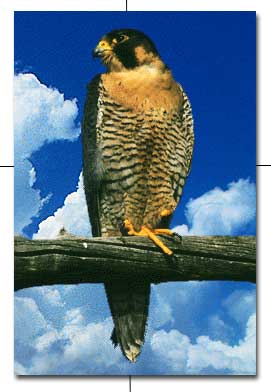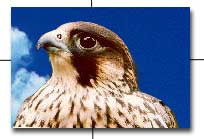

 |
 |
|
|||||||||||||||||||||||||||||||
|
 |
|||||||||||||||||||||||||||
The most reliable distinguishing
feature of the peregrine is the head pattern that is very distinctive,
even from a distance. The peregrine falcon is similar in appearance
to more common Merlin, but is larger with slate blue upper parts, a
white throat and cream-coloured under parts. Blackish-brown bars mark
the sides, thighs, abdomen, underwings, and lower breast area. Male
peregrines weigh an average of 611 grams and females 952 grams.
| Remarks:
Peregrines are capable of soaring to heights of 600m and are among the world's swiftest birds, flying at speeds of more than 200km/h. Peregrine falcons are expert hunters feeding on songbirds, shorebirds, waterfowl, seabirds and pigeons, all of which are caught in flight. The peregrine is anatomically specialized for hunting by direct pursuit in open areas. The prey often tries to escape by gaining altitude but the peregrine uses its speed to stay above the prey, and then dives, killing the prey by a direct blow of the closed fist. |
 |
In Alberta, The peregrine nest on ledges on steep cliff faces or high office towers and can be seen between May and September in downtown Calgary and Edmonton, preying on pigeons in nearby parks. The male will fly complex courtship flights for his mate, and by mid-May the female will lay an average of four eggs. Both adults help incubate the eggs which hatch in mid-June. The young birds are able to fly at about 35-40 days after hatching, but remain dependent on the adults for several weeks after they leave the nest. Peregrines rarely breed before three years of age, with the average life span being four to five years but individuals have been known to live much longer.
Peregrine Falcons, like virtually all birds of prey, now receive legal protection in most parts of North America. Peregrines have been bred in captivity for reintroduction to the wild. In Canada, over 700 peregrines have been produced at the Canadian Wildlife Service breeding facility at Wainwright, Alberta, and in facilities in Saskatchewan and Quebec.
© 2001 University of Alberta Museum of Zoology